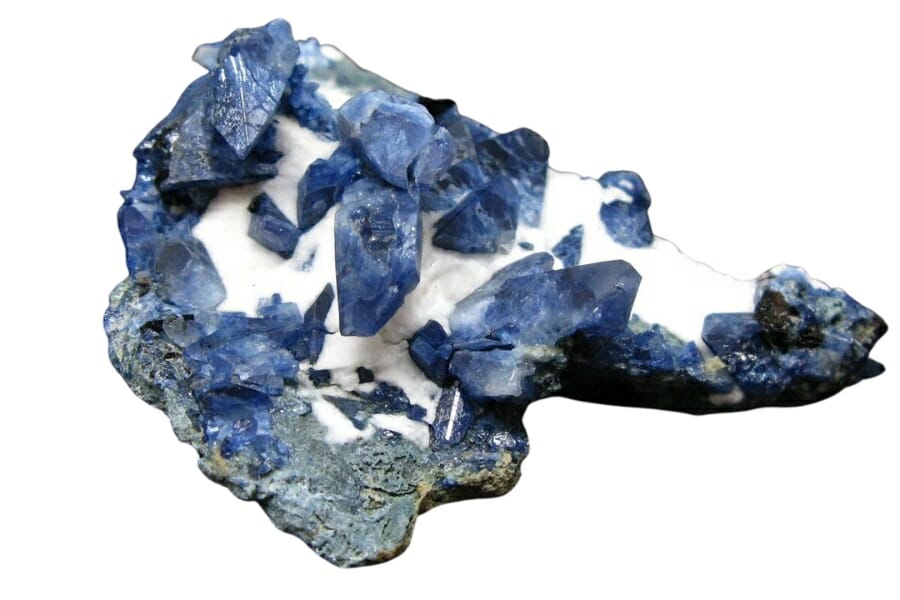With a stunning array of formations, each with its unique character and story, California fascinates rockhounds and nature enthusiasts. It has a treasure trove of extraordinary rocks, minerals, and gems.
The Golden State is a treasure trove of geological wonders, from its rugged coasts to the majestic mountains. Imagine walking along the beach, where the warm sun shines the agates and jasper pebbles. If you go inland, the beautiful crystals and gemstones hidden deep will mesmerize you.
The colorful gemstones, like tourmaline and garnet, are like nature’s own kaleidoscope, with a palette of hues that would make any enthusiast love crystals more.
These rocks also tell stories about the geological history of the state. We see signs of long-gone volcanoes, oceans covered up, and shifting tectonic plates on their surfaces. This tells us about the incredible forces that shaped this land.
Whether you’re a rock collector, an explorer, or just someone who enjoys the beauty of mother nature, California’s geology has something extraordinary for you. Get ready to be amazed and enchanted by the variety and beauty this state has hidden beneath its sunny surface.
To make the most of it, a good guide can be the difference between spotting a treasure and walking right past it. Rock Chasing’s California Rocks & Minerals Identification Field Guide fills that gap, giving you the confidence to identify what you pick up and saving you hours of second-guessing later.
A List of The Common Rocks, Stones, and Minerals Found in California
First, let’s talk about some of the state’s most common rocks and minerals. If you want a full guide, check out the following articles, where we go into a lot of detail:
The California State Rock, Mineral, and Gem
Before we get into the specifics, it’s helpful to know what the official state natural treasures are:
| California State Rock | Serpentine |
| California State Mineral | Gold |
| California State Gem | Benitoite |
Visit the California Department of Park and Recreation to learn more about the state’s geology policy.
Always Confirm Access and Collection Rules!
Before heading out to any of the locations on our list you need to confirm access requirements and collection rules for both public and private locations directly with the location. We haven’t personally verified every location and the access requirements and collection rules often change without notice.
Many of the locations we mention will not allow collecting but are still great places for those who love to find beautiful rocks and minerals in the wild without keeping them. We also can’t guarantee you will find anything in these locations since they are constantly changing.
Always get updated information directly from the source ahead of time to ensure responsible rockhounding. If you want even more current options it’s always a good idea to contact local rock and mineral clubs and groups
Chrysocolla
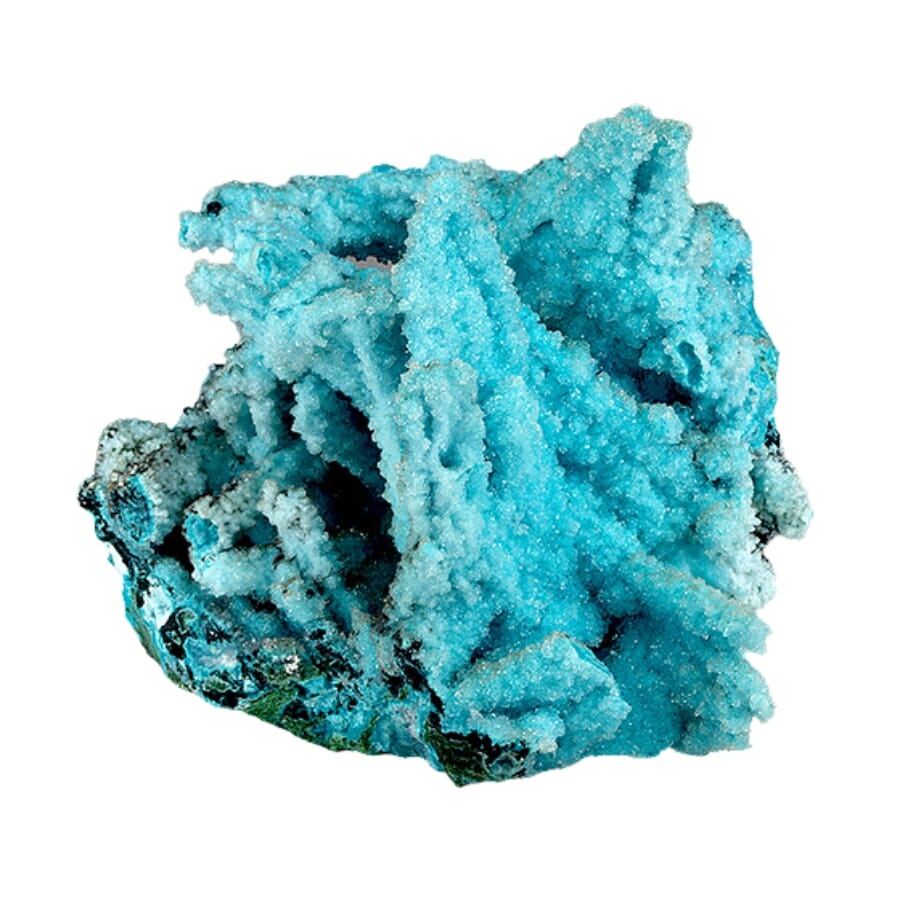
Chrysocolla is a beautiful gemstone; how it was made is just as interesting as how it looks. It’s a mineral of hydrated copper silicate that often forms in the oxidized parts of copper deposits, where copper-rich solutions mix with other minerals and rock formations.
This beautiful specimen comes in many bright colors, such as mesmerizing blues, greens, and turquoise. It often has gorgeous patterns and swirls that look like the way calm lakes and rivers flow.
In California’s geology, which is very different from place to place, you can find different kinds of chrysocolla. The state is known for its deep blue colors and sometimes has sparkling bits of quartz or other minerals mixed in with it.
Ancient people worshipped it because they thought it had magical powers and could help them feel calm and wise. Even today, it’s a stone of communication and expression that helps people express their thoughts and feelings clearly.
Where you can find Chrysocolla in California
Chrysocolla specimens are found at the Blue Bell Mine in San Bernardino County.
Most people don’t realize how many incredible rocks California hides in its mountains, deserts, and beaches. This guide shows exactly what you’ve been walking past.
🌈 300+ color photos of real California specimens
🪨 Raw + polished examples make identification simple
🏜️ Covers coastlines, gold country, Sierras & more
💦 Waterproof pages built for real outdoor use
Cinnabar
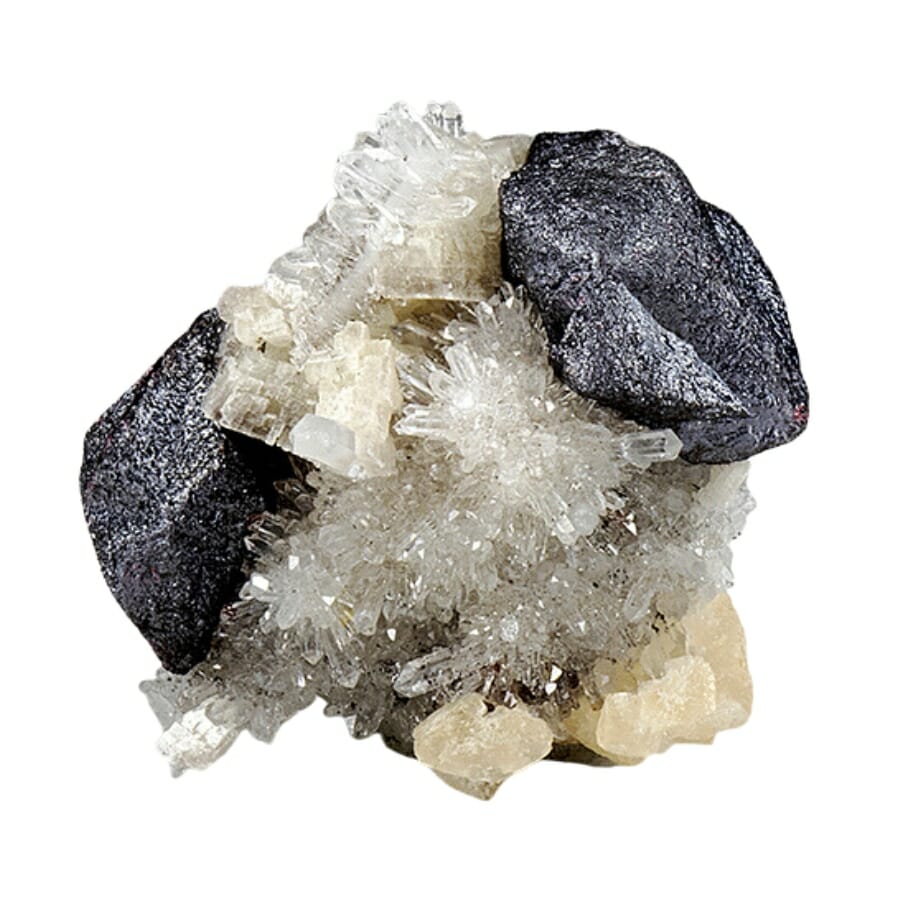
Cinnabar has a long history and strong appeal. Its formation is both exciting and striking. It’s a mineral made out of mercury (II) sulfide and is a bright red color. Its name comes from the Persian word “zanjifrah,” which means “dragon’s blood” because of its intense color.
Most cinnabar is found in hydrothermal veins, where hot, mineral-rich fluids flow through rock cracks. As these liquids cool and mix with other things, it forms bright, fiery colors that look like the heart of a burning fire.
Beyond its intriguing appearance, it holds historical and cultural significance. It has been prized for its vivid red pigment, known as vermillion, used in art and religious rituals for centuries.
Cinnabar’s appeal also comes with caution, as it’s the primary source of toxic mercury. Proper handling and mining practices are essential to protect the environment and human health.
Despite the challenges, the charm of this mineral endures, and its unique beauty and historical associations continue to make cinnabar valuable in the mineral and art world.
Where you can find Cinnabar in California
There are a lot of cinnabar deposits in the state, including in these places:
- Aurora Mine
- Manzanita Mine
- Mt. Diable
Malachite
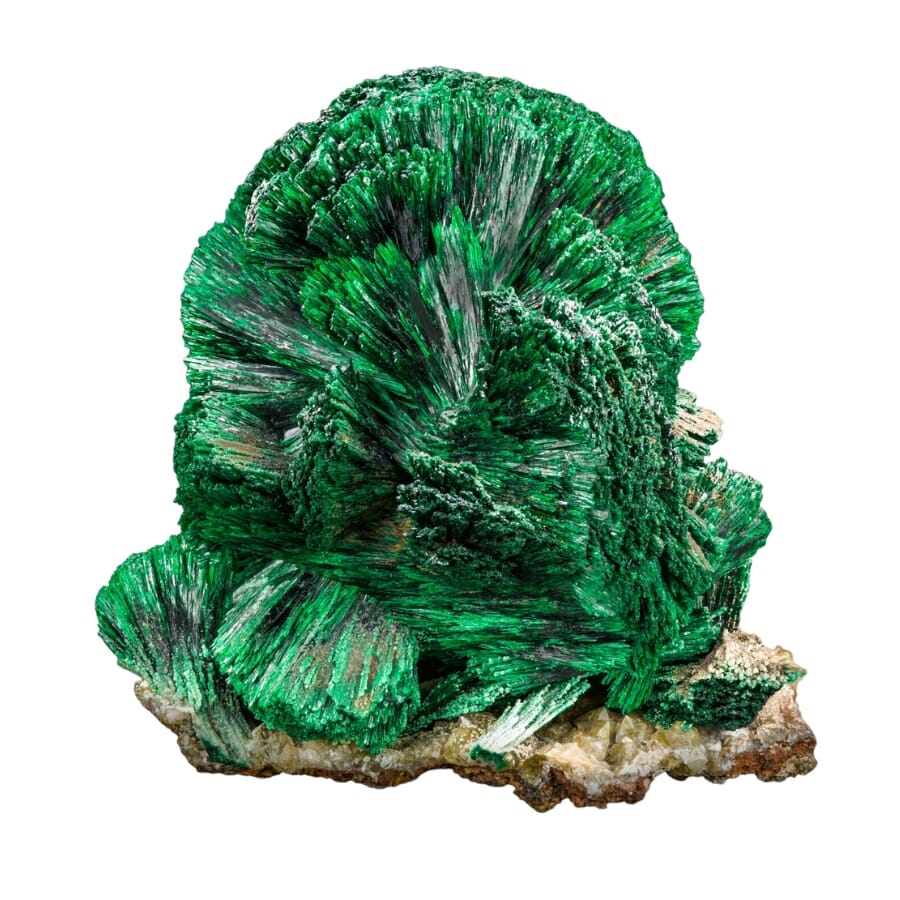
Malachite is a green gemstone with a long history that has fascinated people for thousands of years. It’s a mineral made of copper carbonate and hydroxide. It comes from the weathering of copper ores.
It stands out because of the swirling patterns and bright shades of green that make it look like a lush forest and the beauty of nature. The name “malachite” comes from the Greek word “malakos,” which means “soft.” This refers to the stone’s low hardness, which lets skilled artists carve intricate sculptures and jewelry.
Beyond its eye-catching beauty, malachite is highly valued for its historical and metaphysical significance. The ancient Egyptians used it as a decorative stone and bright green paint pigment.
In many cultures, it is thought to be protective and healing, able to take in negative energies and help people feel more balanced. Its connection to the Earth element adds to its grounding qualities, making it a popular gemstone among crystal lovers.
Where you can find Malachite in California
There are many malachite specimens in California, including the following places:
- Blue Bell Mine
- Copper Prince Mine
- Hughes Mine
- Pocahontas Mine
Obsidian
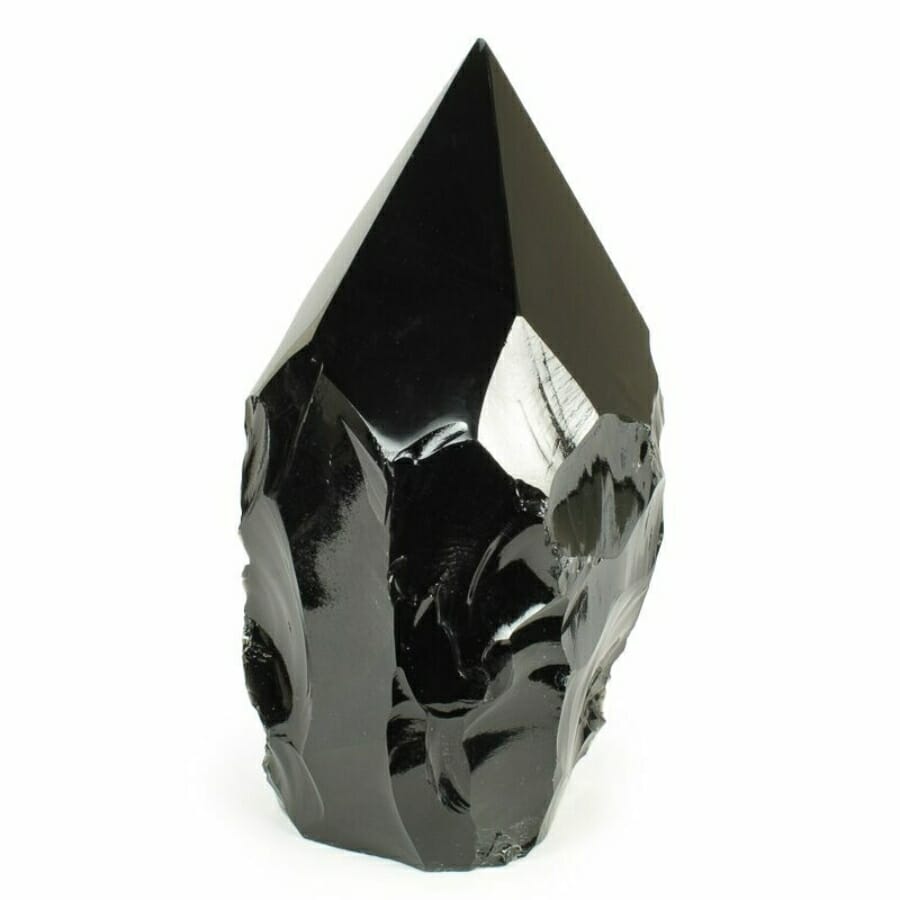
Obsidian, sometimes called “nature’s glass,” is an attractive volcanic glass that has existed since ancient times. It’s made when lava cools down too quickly for crystals to grow, giving it a smooth, shiny, and jet-black look.
This fascinating stone isn’t just black. Depending on what trace elements are in it, it can show a range of mesmerizing colors, such as iridescent blues, greens, and gold.
Many different kinds are found in the geologically varied landscapes of California, and each has its appeal. One popular type is Rainbow Obsidian, known for the beautiful way the light plays with the colors on its surface. The radiance of this type comes from tiny minerals mixed in the glassy structure.
Obsidian has been used for making tools, weapons, and decorative items for thousands of years because it’s smooth and has sharp edges. It’s still a popular material for making knives and blades because it’s very sharp and lasts long. This is why obsidian’s value is worth knowing.
It’s thought to have protective powers and is used to ground oneself and protect oneself from negative energy. Its spiritual meaning is boosted by its connection to the earth. This makes it a good choice for people who want balance and clarity.
If you find yourself struggling to differentiate obsidian from similar rocks and minerals, our expertly crafted guides are here to lend a helping hand, making the identification process a breeze:
Where you can find Obsidian in California
Obsidian is common in California, especially in these places:
- Gem Hill
- Glass Mountain
- Modoc National Forest
- Pisgah Crater
Rhodochrosite
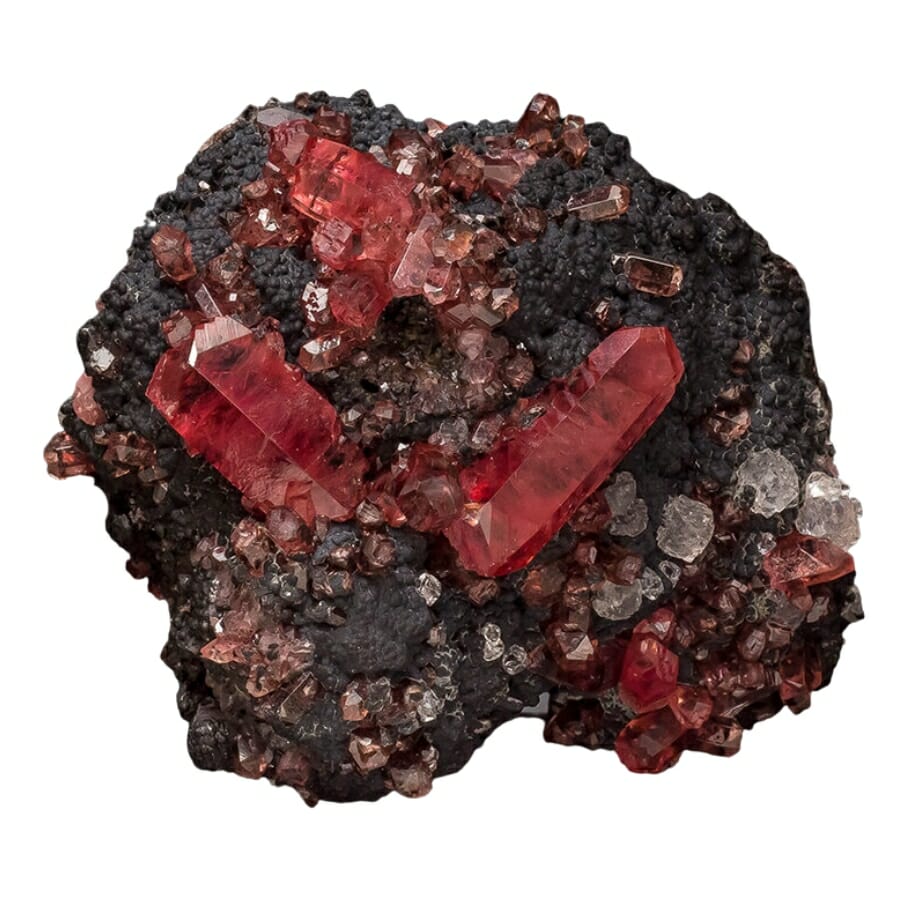
Rhodochrosite is known for its bright pink to red colors and exciting patterns. A manganese carbonate mineral forms when hot, mineral-rich fluids mix with other rocks and minerals in hydrothermal veins.
Manganese gives rhodochrosite its bright colors, ranging from soft pastel pinks to deep ruby reds. These colors make you think of roses in bloom and romantic sunsets. This is often used in jewelry decorations because it looks shiny and has a pretty color.
Besides its beauty, rhodochrosite has essential cultural and spiritual meanings. Ancient people thought it was a stone of love and compassion that helped heal emotions and made people more empathetic.
Some cultures think it relates to the heart chakra, which helps keep relationships in harmony and balance. It’s also considered a stone of happiness and positivity that helps people feel good about themselves.
This gemstone has a lasting value and appeal in the world of minerals and gemology because of its beauty and the way it can be used to heal.
Don’t let the confusion overwhelm you! Our handy guides are here to assist you in distinguishing rhodochrosite from other rocks and minerals, ensuring you never make a mistaken identification again:
Where you can find Rhodochrosite in California
You can find many different rhodochrosite specimens at the Woods Mine in Humboldt County.
Tourmaline
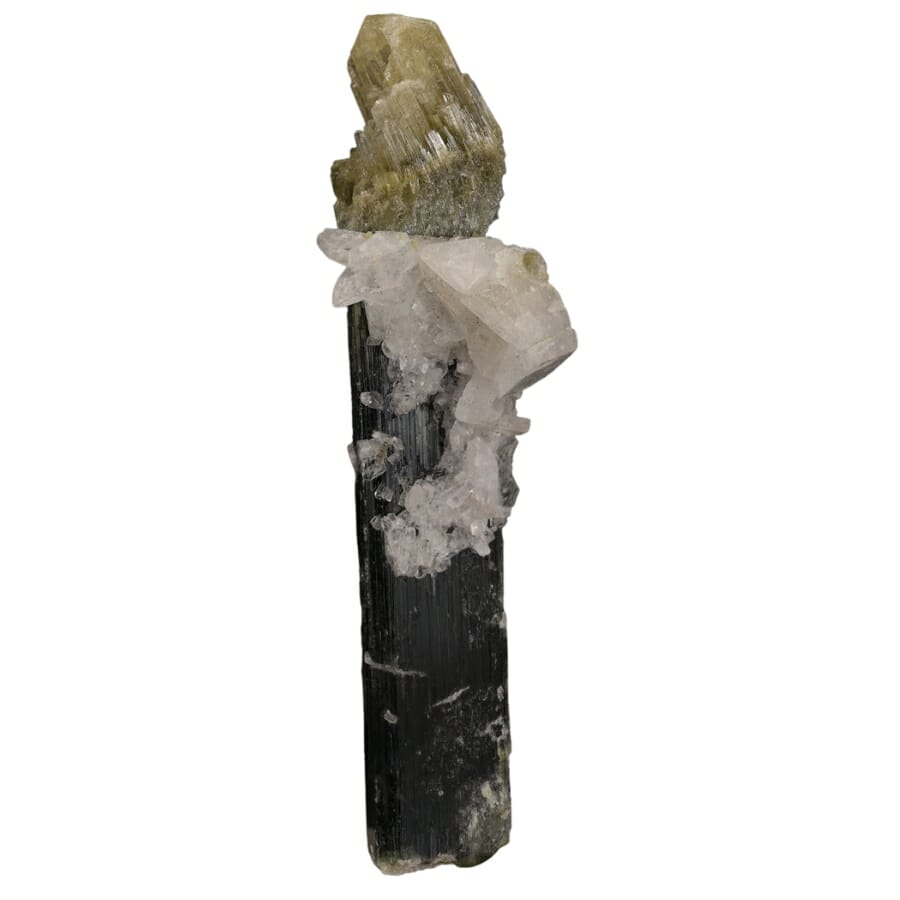
Tourmaline is known for its striking range of colors. This makes it a favorite among gem collectors and people who like to look at stones. It’s a boron silicate mineral that forms in pegmatite veins where hot fluids full of minerals mix with the rocks around them, making the right conditions for tourmaline to crystallize.
It’s distinct from other stones because it has pleochroism, which means that it looks different from all angles. This natural kaleidoscope of colors has lush greens, electric blues, and even colors that look like watermelon slices.
This delicate and girly gemstone has beautiful shades of pink, from light pastels to deep magenta, which resembles flowers in bloom. California is also home to the colorful Watermelon Tourmaline, which looks like the fruit because it’s green on the outside and pink in the middle.
It’s thought to have many healing properties, such as balancing emotions, boosting creativity, and building self-confidence. Some cultures believe tourmaline can protect against harmful energies and keep you grounded.
Where you can find Tourmaline in California
In California, there are a lot of tourmalines, particularly in these areas:
- Benitoite Mining Company
- Hatfield Creek
- Lake Henshaw
- Tourmaline Queen Mountain
The Gemstones Found In California
Let’s talk more about the gemstones that can be found in California. If you want a complete guide, we’ve also put together a list of the very detailed articles we’ve written:
Amethyst
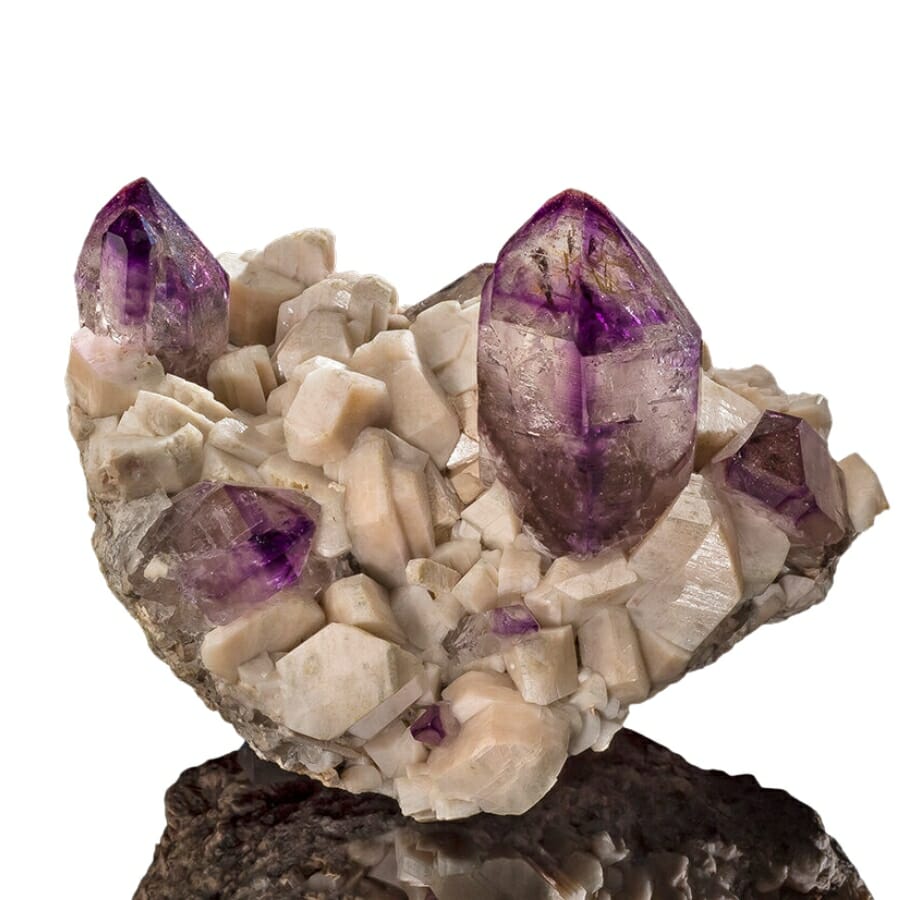
Amethyst is a purple gemstone that has been loved for centuries for its beauty and what people think is its magical powers. It’s a type of quartz, and the purple color comes from tiny amounts of iron in its crystal structure.
It’s made when hot mineral-rich fluid flow through hydrothermal veins and mixes with the rocks around them. This creates the perfect environment for quartz crystals to grow. Its purple color can range from lilac to a deep royal purple, which makes you think of royalty and spiritual enlightenment.
Throughout history, it has been highly valued for what are thought to be its magical properties. Ancient people thought it was a protective stone that kept away bad energies and helped them feel calm and peaceful.
Some people think of amethyst as a sign of spiritual wisdom and insight, and they use it in meditation to improve their intuition and sense of connection to higher realms. Its historical value as a stone of sobriety and clarity adds to its worth.
Whether loved for its stunning color or spiritual properties, amethyst will always be a fascinating and valuable gemstone in the world of minerals and gemology.
Where you can find Amethyst in California
We’ve created a complete guide on where to find amethysts in California. Once you’ve been to those places, you can also try finding them in these areas:
- Crystal Ridge
- Escondido Canyon
- Shelter Cove
Aquamarine
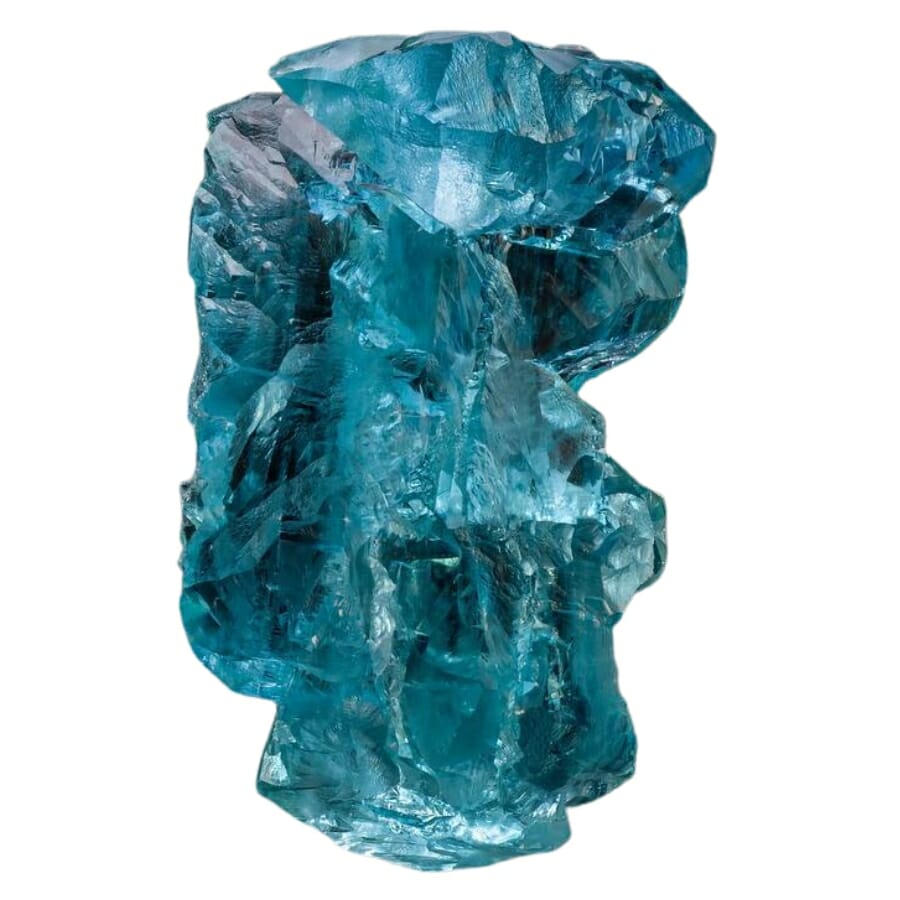
Aquamarine has soothing blue colors that remind people of the calm water of the ocean. It’s a type of mineral beryl related to emeralds. Its beautiful blue color comes from traces of iron in its crystal structure.
It forms in pegmatite veins and cavities in granitic rocks, where hot mineral-rich fluids mix with the minerals around them, making the perfect environment for beryl crystals to grow.
The gemstone has soft blue colors that range from pale sky blue to bright aqua. Both people who like gems and people who want jewelry are drawn to it. Ancient cultures believed it to be a stone of courage and protection, especially for travelers and sailors, offering safety during journeys over water.
Aquamarine is also associated with emotional healing and clarity, inspiring calmness, peace, and harmony. Its association with the water element further enhances its metaphysical properties, making it a favored gemstone among those seeking balance and tranquility.
If you want to know how much aquamarines are worth, check out our article.
Where you can find Aquamarine in California
Aquamarine can be found all over California, especially in the following places:
- Cahuilla Mt.
- Lake Henshaw
- Williamson Mine
- Tourmaline Queen Mountain
If you’re having a hard time distinguishing aquamarine from other rocks and minerals, refer to the guides below:
Diamond
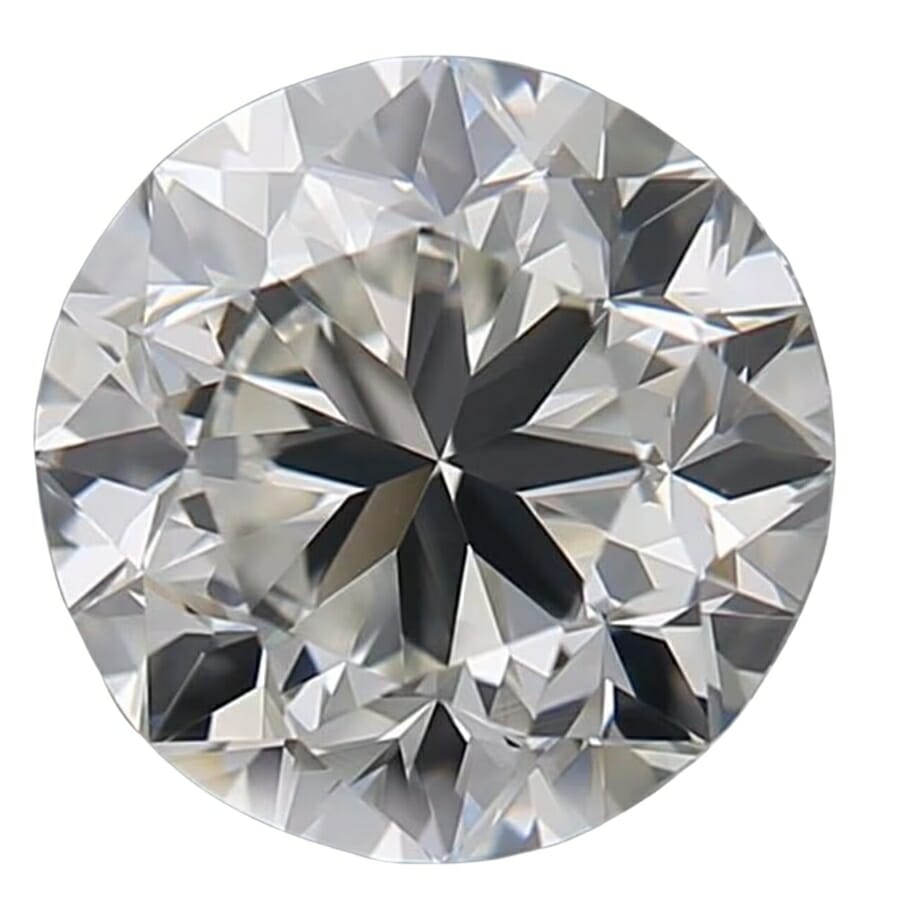
Diamond, the king of gemstones, has captured people’s hearts for hundreds of years with its incredible shine and beauty. It’s a valuable gem made of carbon atoms arranged in a crystal lattice, which gives it a hardness and brilliance that are hard to beat.
Deep in the Earth’s mantle, carbon-rich materials go through a process that take billions of years and a lot of pressure and heat. The result is a beautiful gem called a diamond. When diamonds are made, volcanic eruptions send them to the surface of the Earth, where they can be found in kimberlite pipes and alluvial deposits.
In the 19th century, diamonds were found in the state in the area of Oroville, which is why the state is known for that. Most of these diamonds were alluvial, meaning water carried them from their source rocks to their present locations.
Their high value comes from how rare they are and their timeless beauty. This makes them a status symbol and a treasure that will be passed down from generation to generation.
Diamonds are the most valuable and fascinating gemstones because of how they were formed in the earth, how beautiful they are, and what they mean to different cultures.
Where you can find Diamond in California
You can find Diamonds all around California, particularly in these places:
- Jackson’s Gulch
- Thompson’s Flat
- Yankee Hill
Garnet
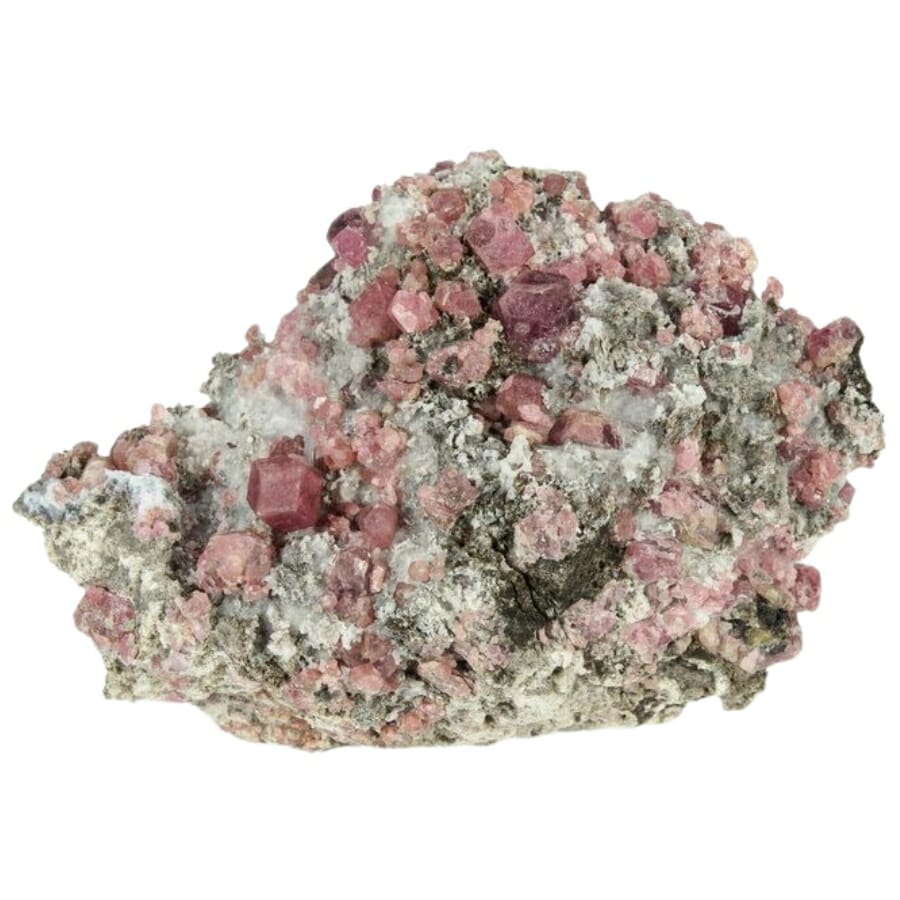
Garnet has a wide range of colors valued throughout history for its charm and versatility. It’s a group of silicate minerals with the same crystal structure but different chemical compositions.
This gives them a beautiful range of colors, including deep reds, bright oranges, striking greens, and mesmerizing purples. Garnets can form in many types of rocks, such as metamorphic, sedimentary, and igneous.
When minerals high in aluminum and silica come into contact with other elements, they change into garnets, which are beautiful gemstones. The name of this gem is thought to come from the Latin word “granatum,” which means “pomegranate,” because it looks like the fruit’s bright red seeds.
They are appealing for more than just how they look. It’s valued for what it can do for you and what it means in history. Garnets are thought to increase passion, creativity, and emotional balance in many cultures. People think of them as protective stones that stand for love and loyalty.
It has been used in jewelry and artifacts for a long time, from ancient Egyptian amulets to royal regalia from the Middle Ages. This shows garnet’s lasting value and cultural significance.
Where you can find Garnet in California
Garnets are abundant in California, especially in the places listed below:
- Santa Rite Peak
- San Carlos Mine
- Shady Run
- Slick Rock Canyon
- Traverse Creek
Jasper
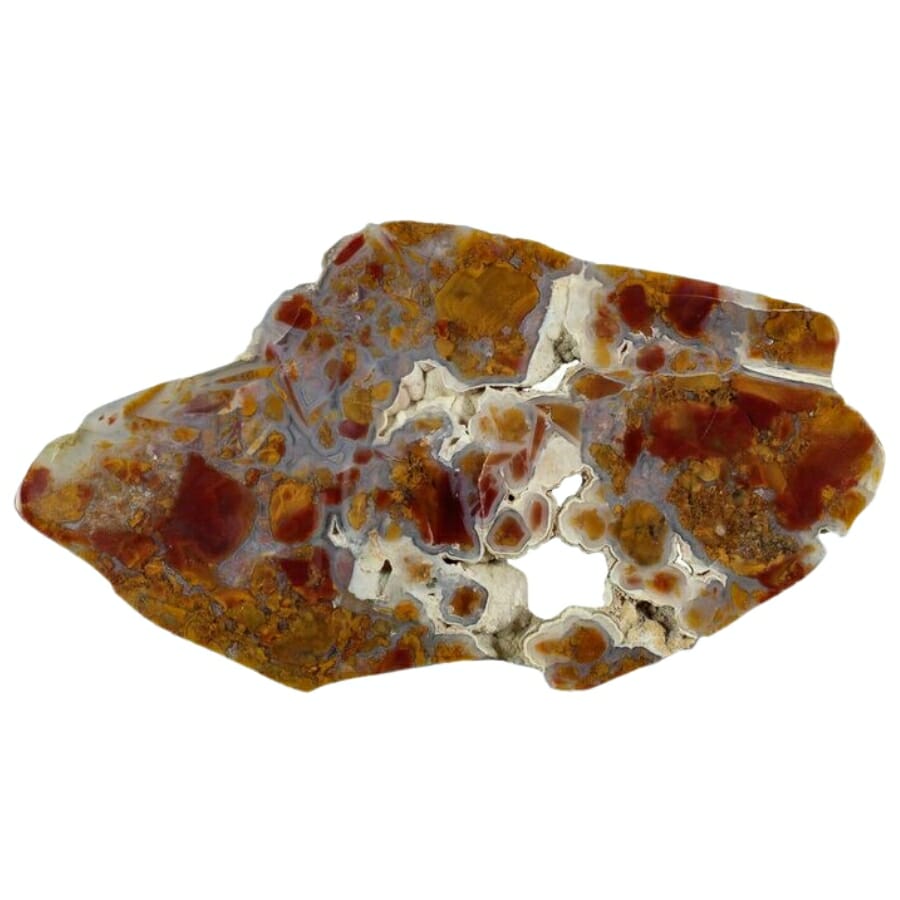
Jasper is known for its deep, earthy colors that remind people of beautiful landscapes and other natural things. It’s a type of chalcedony, which is a microcrystalline form of quartz. Its different colors came from impurities and minerals when it was made.
Slow mineral deposition in sedimentary rocks, where layers of silica-rich materials slowly build up over time. Each piece is unique because of the patterns and colors made by the layers.
One remarkable specimen in California is the Ocean Jasper, which features stunning combinations of blues, greens, and whites that resemble the mesmerizing colors of the ocean and coastal landscapes.
Some think that jasper can connect people to the earth’s energies and help them feel more balanced and harmonious. Because of this, it’s a popular gemstone for people who want to learn more about the natural world.
If you’re curious about jasper’s price, we’ve created an article with all the information you need to know.
Where you can find Jasper in California
Jasper can be found in a lot of places in California, especially in the following places:
- El Paso Mountains
- Point Sur
- Red Rock Canyon
- Stonyford Creek
- Sue-Meg State Park
Moonstone
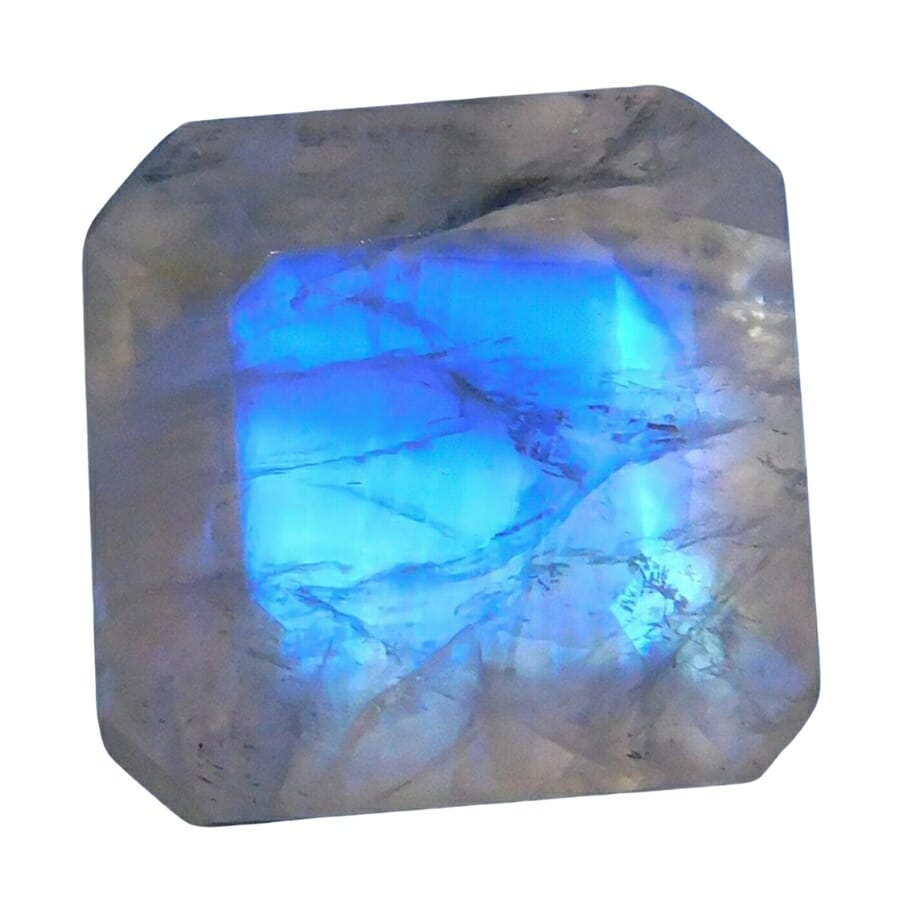
Moonstone is admired for how it plays with light and looks like it came from another world. It’s a type of feldspar, a group of minerals that includes sunstone and labradorite.
The shimmering light that seems to move across the surface of the moonstone is called “adularescence.” It’s caused by a process called “schiller” or “sheen.” This optical effect happens when light hits the thin layers of feldspar in the stone.
It’s made in pegmatite veins and metamorphic rocks, where molten rock cools and lets feldspar minerals form into beautiful gems.
Moonstone is often linked to feminine energy and the phases of the moon, making it a famous stone for people interested in spirituality and intuition. It’s thought to help keep your emotions in check, boost your creativity, and give you a sense of inner harmony.
Some cultures believe that it’s a protective stone that can bring luck and love. Its mesmerizing shine and reputation as a mysterious and magical stone help keep its value and appeal in the mineral and gem world.
Where you can find Moonstone in California
Moonstone is abundant in California, mainly in the following areas:
- Redondo Beach
- Sue-Meg State Park
If your kids constantly ask “What’s this rock?”, this guide finally gives you an answer you don’t have to Google later. Quick photos, simple descriptions, and rugged pages make ID’ing rocks fun instead of frustrating.
🔍 Fast visual matching—no geology background needed
💦 Wipe-clean pages made for creeks, beaches & dirt
📚 Simple explanations for beginners of all ages
🌄 Great for California hikes, creek beds & camping trips
Opal
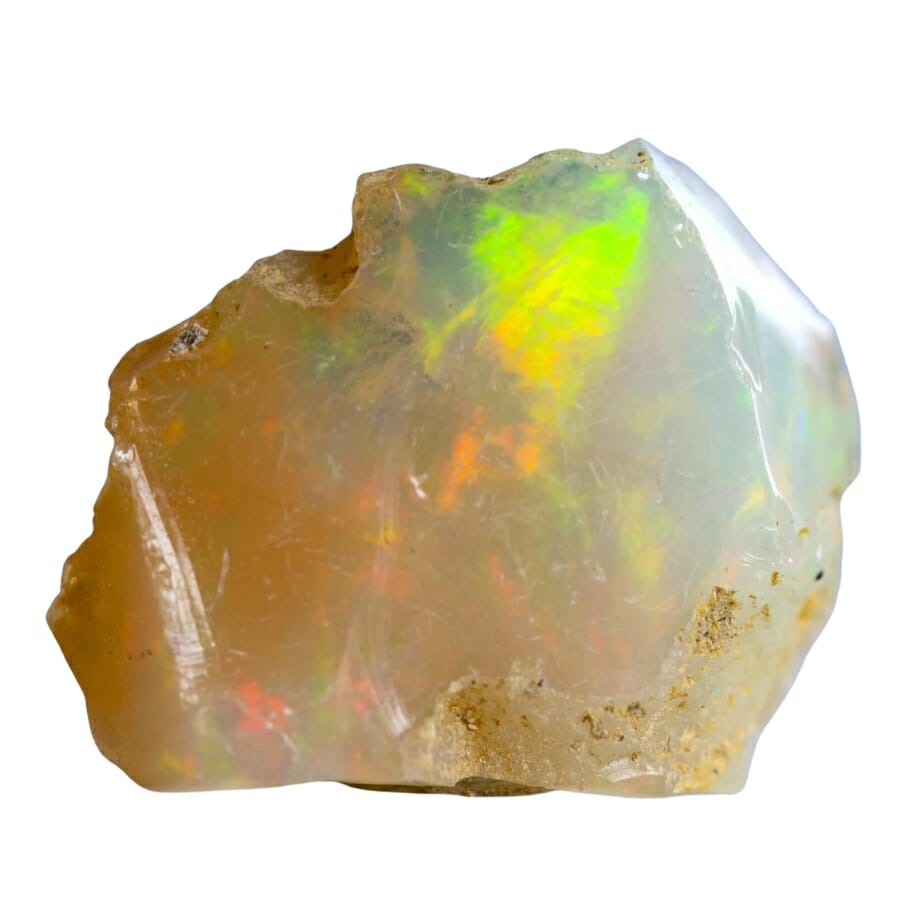
Opal is a mysterious-looking gem known for the stunning way its colors dance and shimmer when light hits its internal structures. It’s an amorphous, hydrated form of silica with different amounts of water, which gives its iridescence.
They are made when silica-rich water seeps into cracks and holes in sedimentary rocks. Over time, the water evaporates, leaving behind silica spheres that scatter light and create a mesmerizing show of colors.
The range of opal colors can be bright blue, lively green, fiery red, and brilliant orange.
One variety that stands out is the fire opal, which has bright orange to red colors that look like the warm glow of a flame. They are made in volcanic rocks, and their bright colors are caused by iron oxide and other impurities.
People often think of opal as a source of creativity, inspiration, and emotional healing. Some cultures believe it can bring good luck and is a stone of hope and love. They are known for their ties to the spiritual world, making them a favorite among people interested in minerals and gems.
Where you can find Opal in California
You can find a lot of opals in California, particularly in these places:
- Chocolate Mountains
- Hooten Ranch
- Opal Hill Mine
- Red Rock Canyon
- Sailor Flat
Turquoise
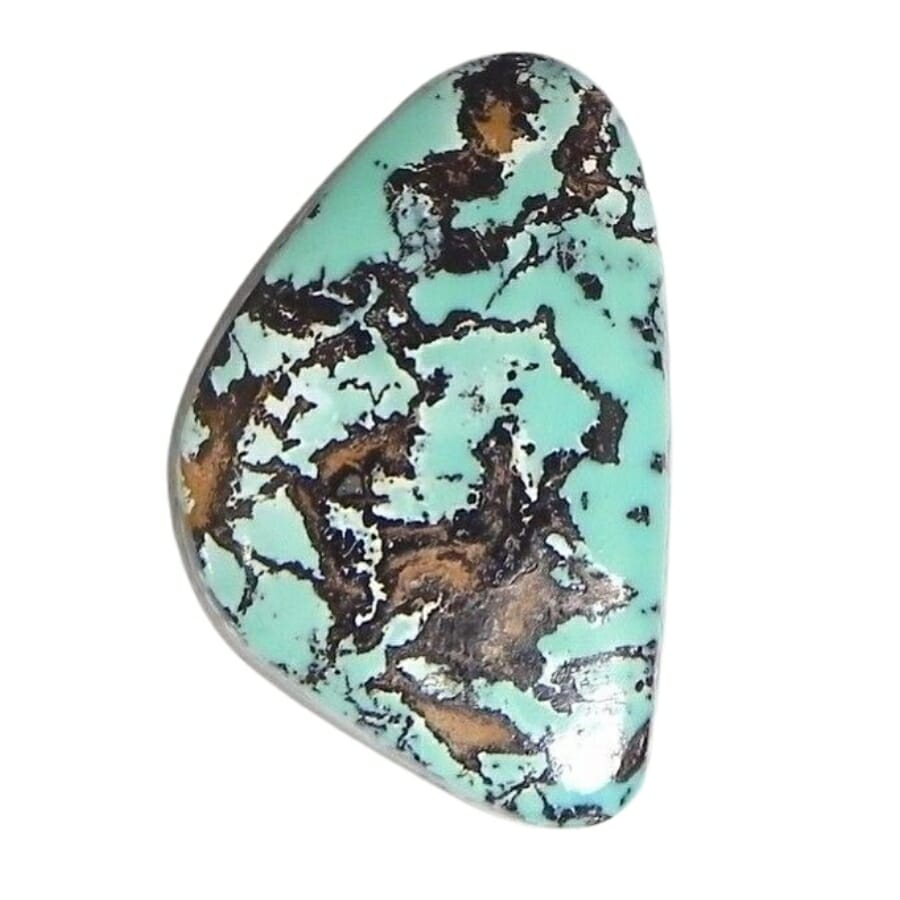
Turquoise is a water-soluble phosphate mineral that forms when water moves through rocks rich in copper and reacts with phosphate and aluminum minerals.
The gem’s color comes from how these elements are put together. It’s often found in dry, arid places because the dryness helps keep the delicate color of the stone.
The history of this gemstone goes back to ancient civilizations, where it was used to decorate jewelry, ceremonial objects, and even burial masks. It stood for protection, wisdom, and a connection to the divine.
Turquoise is a protective stone in many cultures that helps people be strong and brave. It’s thought to help people feel calm and peaceful, improve communication, and control their emotions.
It’s also thought to have healing powers. It has been used for centuries in alternative medicine to treat physical and spiritual illnesses.
Turquoise is a gemstone that has always been interesting and valuable because of how it looks and what it means to different cultures.
Where you can find Turquoise in California
Turquoise can be located in California in these places:
- Chocolate Mountains
- Lake Havasu
- Last Chance Range
- Silver Mom Mines
To help you tell turquoise apart from other very similar rocks and minerals, refer to our guides below:
The Crystals Found In California
Many beautiful crystals that collectors and enthusiasts value highly can be found in California. We’ve given a lot of information about these crystals below.
You can also read our article about where to find crystals in California:
Beryl
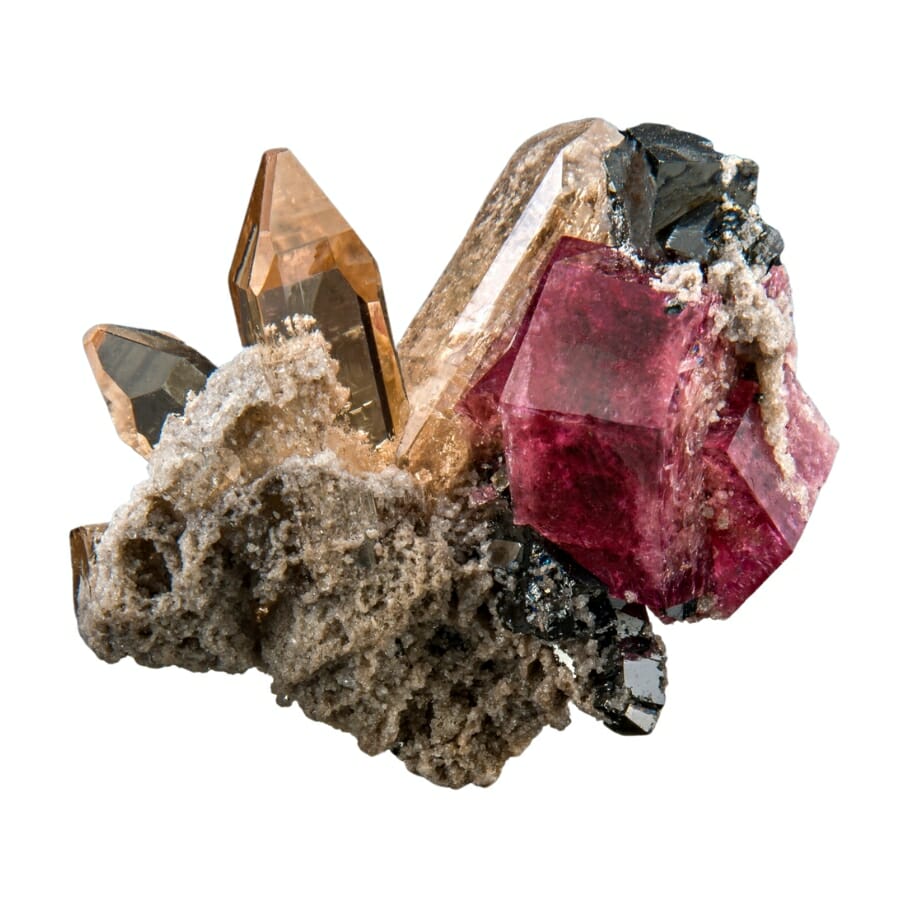
Beryl is celebrated for its wide range of colors and exceptional transparency. It’s a beryllium aluminum silicate mineral that forms in pegmatite veins and granite rocks when hot mineral-rich fluids mix with the stones, creating the conditions for crystals to grow.
What makes it stand out is that it can be different colors when different trace elements are present. It can be green, blue, or pink, like emerald, aquamarine, or morganite.
Its crystals can also grow very big, making them a popular material for beautiful gemstones and decorative pieces. This gemstone is one of the hardest, which makes it good for jewelry that you can wear every day.
Beryl’s clarity and range of colors make it a favorite among gem lovers, and it can be used in various styles and designs. Each type also has a different meaning. Emerald represents growth and renewal, aquamarine represents peace and communication, and morganite represents love and kindness
Where you can find Beryl in California
Beryl is easy to find in California, specifically in these locations:
- Cahuilla Mountains
- Hatfield Creek
- Oceanview and Pala Chief Gem Mines
- Ware Mine
Kunzite
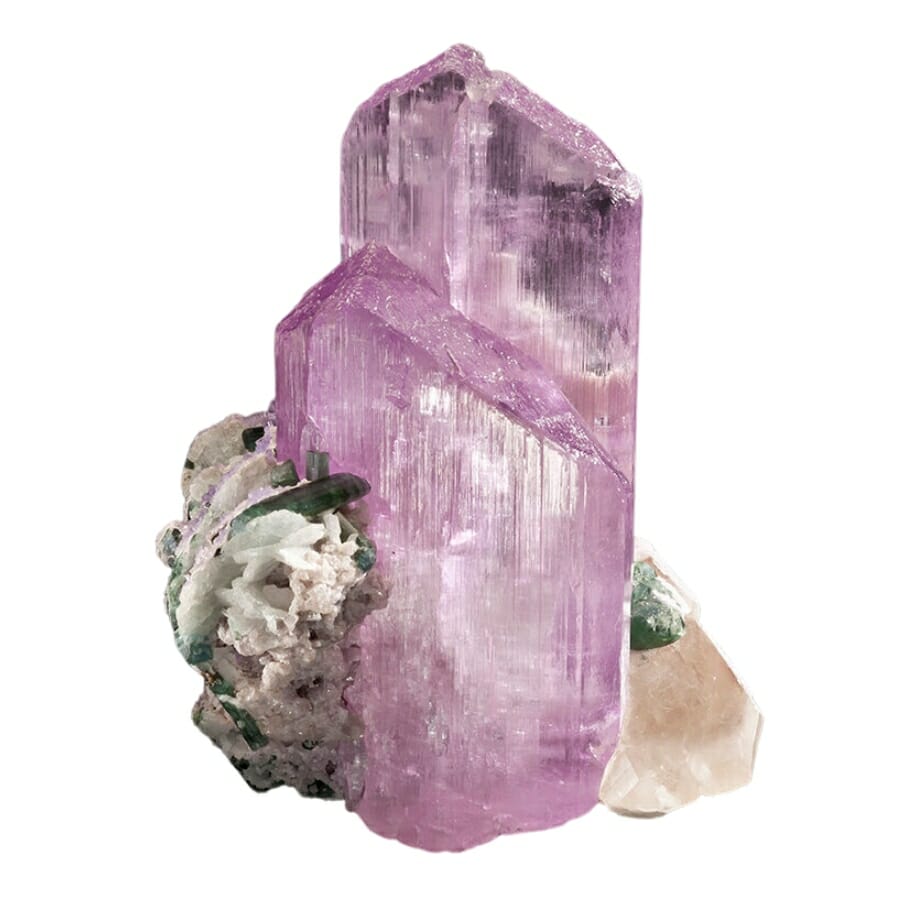
Kunzite is a beautiful gemstone known for its soft pastel colors and transparency. It’s a type of spodumene, a lithium aluminum silicate mineral. Traces of manganese and other elements give it a soft pink to lilac color.
It’s made when hot mineral-rich fluids flow through granite pegmatite veins and mix with the rocks around them. This makes the perfect environment for spodumene crystals to grow.
Once made, its crystalline structure lets light pass through with exceptional clarity. This allows the colors to shine through mesmerizingly, catching the attention of gem lovers everywhere.
Kunzite is thought to have calming and healing properties that help keep emotions in check and make people feel more love and compassion. Some cultures believe it is related to the heart chakra and use it to strengthen emotional bonds and encourage self-love.
The fact that it is connected to water adds to its spiritual meaning, making it a popular gemstone for people who want peace and harmony. Its delicate beauty, reputed magical properties, and rarity make kunzite a valuable mineral and gem.
Where you can find Kunzite in California
Kunzite can be found in these areas in California:
- Oceanview Mine
- Tourmaline Queen Montain
Lepidolite
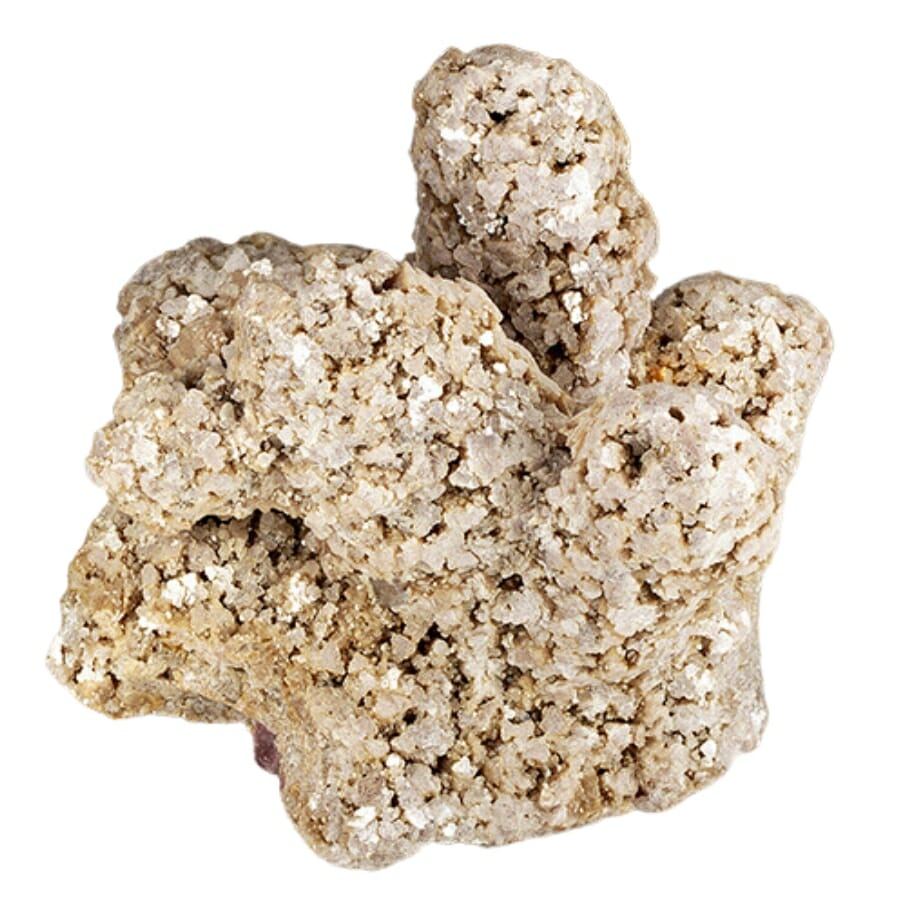
Lepidolite is known for its lilac, soft pink tones and connection with emotional healing and peace. It’s a secondary mineral that forms in the veins of granite pegmatite. It’s a mica mineral that’s high in lithium.
Manganese and other trace elements in the crystal lattice of lepidolite are responsible for its beautiful color. It’s a type of mica with a sheet-like structure that shims when light hits its surface.
Lepidolite is very valuable because it is thought to have healing properties and has metaphysical properties. It’s believed to bring emotional balance and help with stress, anxiety, and other problems.
People believe that it can help them feel calm and relaxed. This makes it a popular gemstone for people who want to calm their minds and find inner peace. It’s also linked to the heart chakra, which helps people feel more love and compassion for themselves and others.
Where you can find Lepidolite in California
Check out the following places to find unique pieces of lepidolite:
- Himalaya Tourmaline Mine
- Victor Mine
- Ware Mine
Morganite
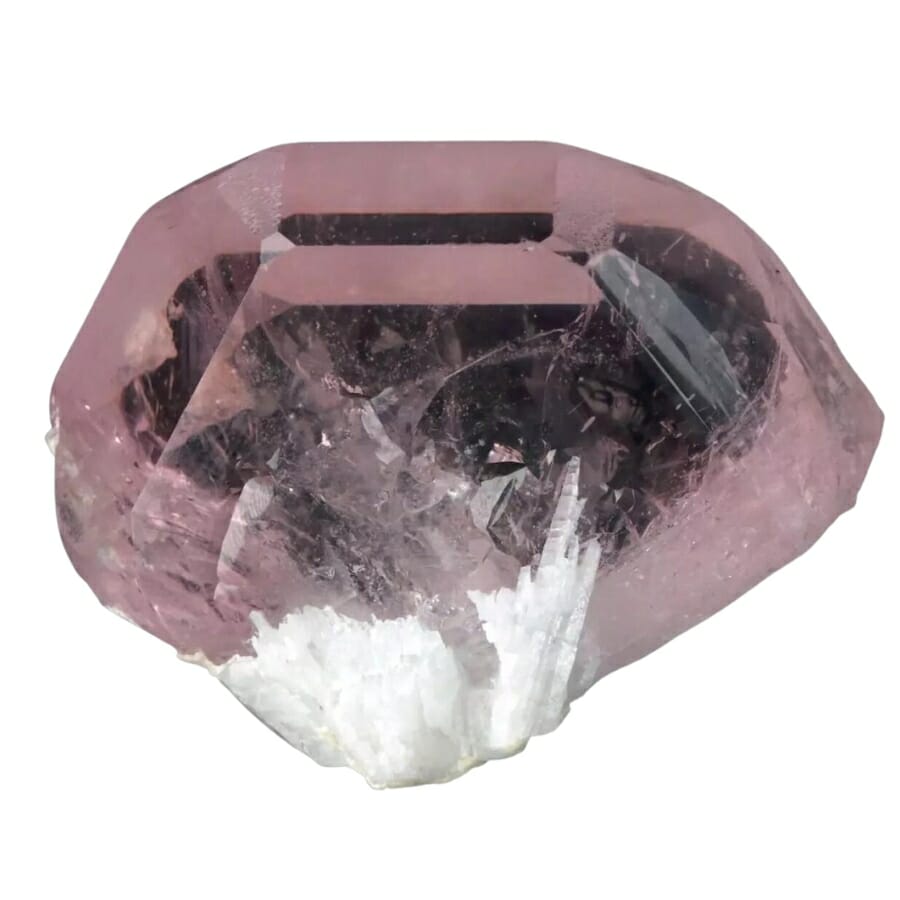
Morganite is known for its soft pink to peachy colors and stunning shine. It’s a type of mineral beryl related to emerald and aquamarine. Its beautiful color comes from traces of manganese in its crystal structure.
It forms in pegmatite veins and granite rocks, where hot mineral-rich fluids mix with the surrounding stones, creating the conditions for beryl crystals to grow. The soft pink colors of the gem make people think of romance and tenderness, making it a popular choice for engagement rings and other sentimental jewelry pieces.
The Rose beryl is a kind of morganite usually found in pegmatite rocks. Its delicate coloration and exceptional clarity make it highly sought after by gem collectors and jewelry designers.
People also think that the gem makes people more creative and helps them feel calm and peaceful. Because of its beautiful color and the belief that it can heal, morganite is a highly valued gemstone in the world of minerals and gemology. Its soft beauty has won the hearts of many.
Where you can find Morganite in California
You can locate morganite in the following areas:
- Himalaya Tourmaline Mine
- Lake Henshaw
Morganite is often mistaken for similar rocks and minerals, so to help you through this, here are some guides to help you tell it apart from others:
Pyrite
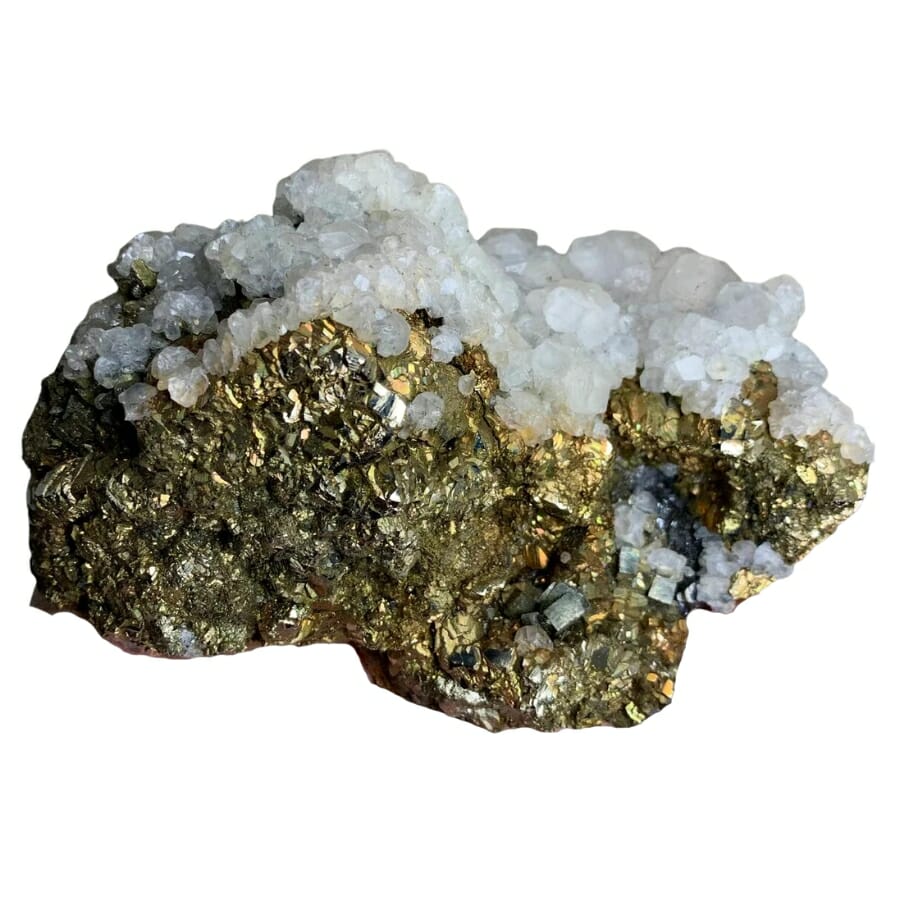
Pyrite is a fascinating mineral that looks like real gold and has a metallic shine and brassy yellow color. It’s a mineral of iron sulfide that can form in several geological settings, including hydrothermal veins, metamorphic rocks, and sedimentary deposits.
It’s made when high-temperature fluids mix with sulfur and iron and causes them to crystallize into complex cubic or pyritohedral shapes. Even though pyrite looks like gold, it’s not. It has been mistaken for gold throughout history, which is why it’s called “fool’s gold.”
Because of its high sulfur content, you can find sulfur-rich pyrites in California, which feature bright yellow to golden hues. This type of pyrite is often found in hydrothermal veins and is valued for its vibrant coloration and impressive crystal formation.
In the industrial world, pyrite is used to make sulfuric acid and as a source of sulfur in many manufacturing processes. It’s thought to help with grounding, protection, and abundance in metaphysics.
People think of it as a stone of confidence and prosperity that allows people to have a positive outlook and work hard to reach their goals.
Where you can find Pyrite in California
It’s not hard to find pyrite in California, especially in these locations:
- Golden Jubilee Mine
- Sue-Meg State Park
Quartz
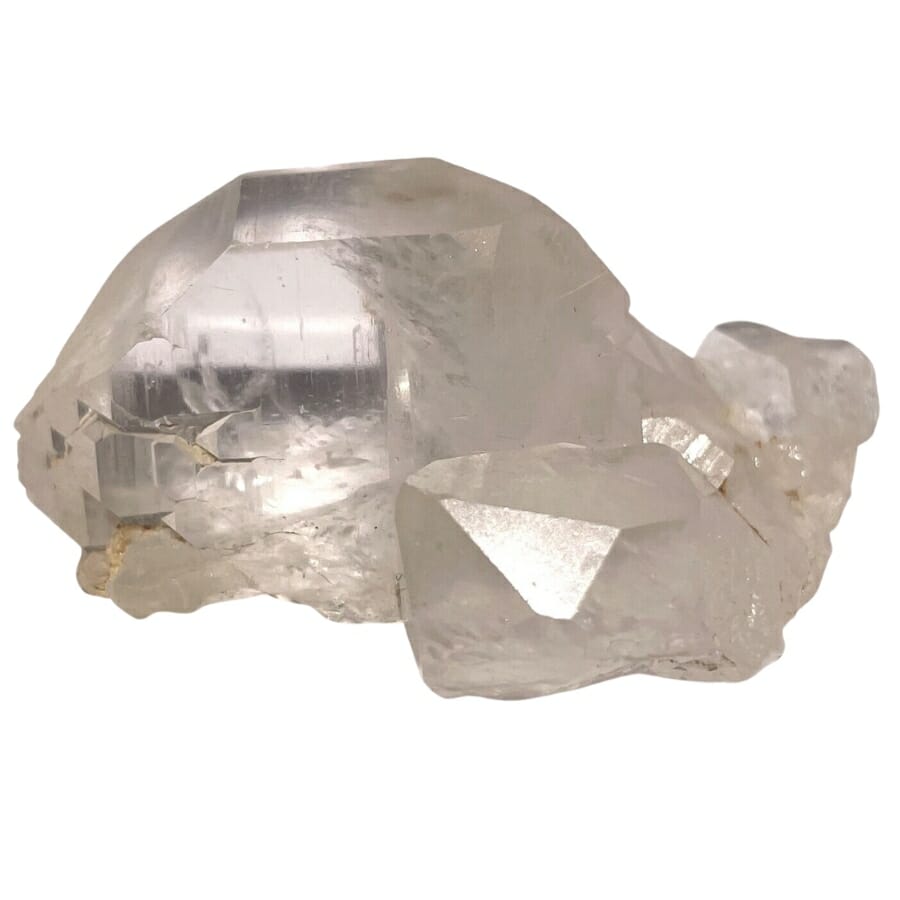
Quartz is a common mineral that can be used in many ways and comes in a wide range of colors and crystal shapes. It’s made up of atoms of silicon and oxygen that are arranged in a continuous framework, giving it exceptional hardness and durability.
It can form in igneous, metamorphic, and sedimentary rocls, among other geological places. It’s often made when hot mineral-rich fluids mix with the rocks around them. This leads to the slow crystallization of quartz in cracks and cavities.
The different colors like clear, smoky, rose, and amethyst, come from trace elements that were in the rock when it was made. Both smoky quartz and clear quartz are common in the state of California.
Quartz is highly valued because it can be used in different ways. This makes it one of the minerals that is used the most in many different fields. It’s not only a known gem, but it’s also an important part of making glass, ceramics, and electronics.
Across cultures, it’s considered as a stone of energy and balance. It’s thought to help with spiritual growth and bring clarity and focus. It can make intentions strongers and can be used in meditation and healing.
Where you can find Quartz in California
To find unique specimens of quartz, you can explore the places listed below:
- Feather River
- Lime Kiln Creek
- Little Acorn Mine
- Opal Hill Mine
- Slickrock Canyon
The Most Valuable Rocks and Minerals in California
Now, let’s talk about the rocks that everyone loves. Here are the rocks and minerals that can help you make more money when you find them:
Benitoite
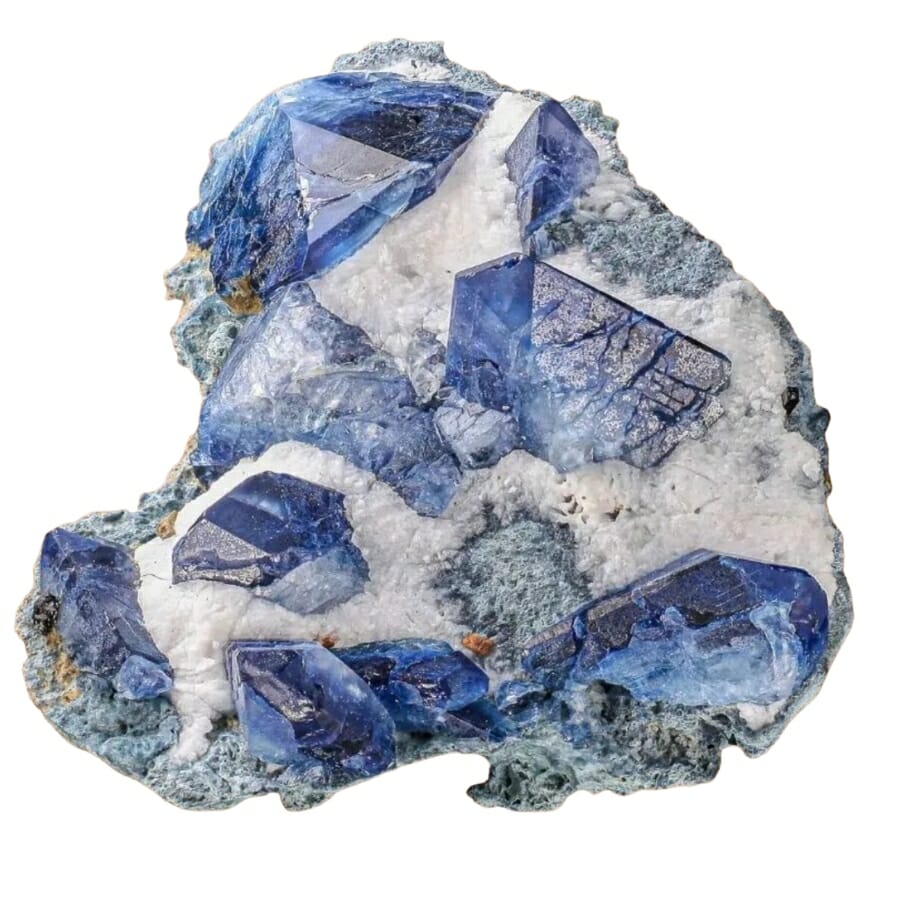
Benitoite is a rare and beautiful gemstone that is known for its beautiful blue color and high level of brilliance. It’s a mineral made up of barium, titanium, and silicate. It was first found in California, which makes it the official state gem.
Benitoite got its name from the county in California where it was first found, San Benito. The gem is found in serpentinite rocks and is often found near natrolite and neptunite veins.
Its beautiful blue color comes from the tiny amounts of titanium and other elements in its crystal structure. The color of the gem can be anywhere from light blue to deep indigo, just like sapphires.
As the state gem of California, it has special meaning for the area because it represents the state’s natural treasures. The gemstone is hard to find and doesn’t happen very often, which makes it a valuable item for collectors and a sought-after gem in the jewelry market.
Benitoite’s unique blue color and amazing brilliance give it a sense of wonder and elegance. This makes it a mineral and gemologist favorite that will always be interesting and valuable.
Where you can find Benitoite in California
You can find unique specimens of benitoite at the Benitoite Mining Company, among many places.
Serpentine
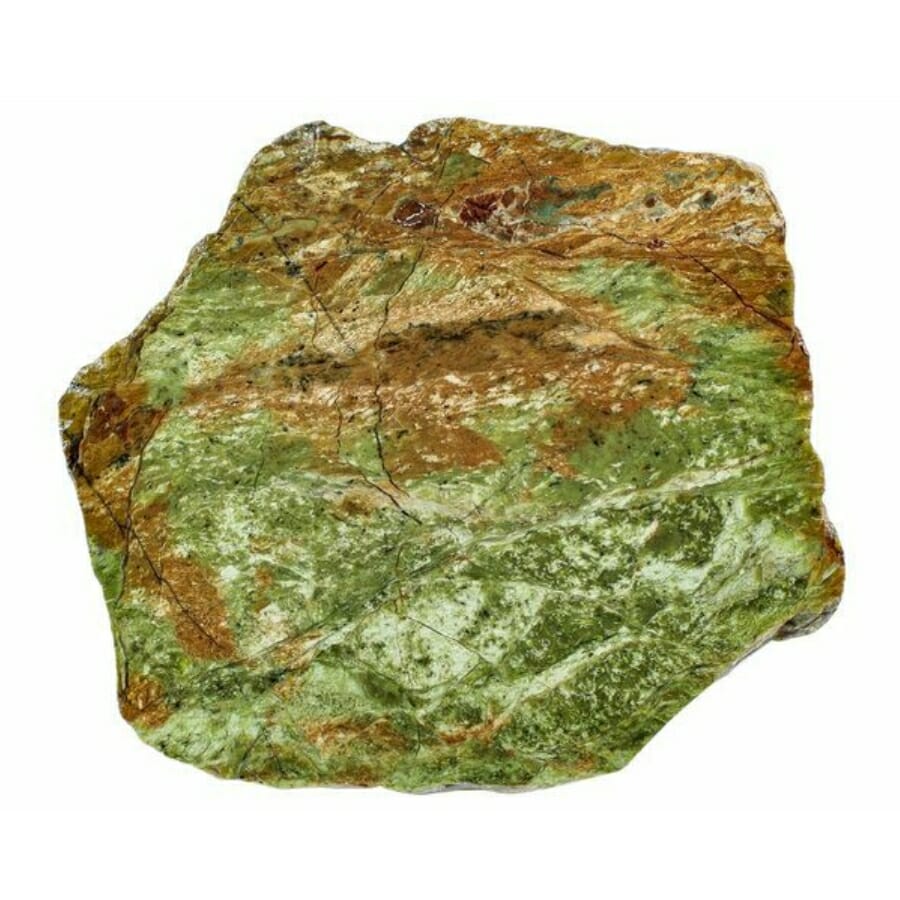
Serpentine is a group of minerals with a lot of different colors and patterns that make it look like the skin of a snake. It’s a water-soluble magnesium iron silicate mineral that forms in metamorphic rocks and hydrothermal veins, among other places.
It’s made when rocks with a lot of magnesium and iron are changed by high temperatures and pressure. Different types of serpentine have their own colors and textures because of how these elements came together and how much water was around when they formed.
It’s a very valuable stone because it can be used in many ways and has historical value. Due to its beautiful colors and ease of carving, serpentine has been used throughout history to make statues, decorative items, and building parts.
The different colors of serpentine, like green, yellow, and black, add to its beauty and make it possible to use it in many creative ways. It was also thought to have metaphysical properties that help people heal, feel safe, and connect with nature.
Where you can find Serpentine in California
Serpentine can be found in many places, among them are:
- Aurora Mine
- Escondido Canyon
- Point Sur
- Trinity River
- Watts Valley
How to Identify The Rocks and Minerals You Find
Rock and mineral identification is important for many reasons. It helps us learn about the geological history of a place, figure out how valuable mineral deposits might be, and enjoy the beauty and variety of Earth’s treasures.
Sometimes it’s hard to tell what a mineral is because there are so many of them and they all have different properties. It requires careful observation, knowledge of how minerals are made, access to good resources, and sometimes testing new equipment.
If you’re not sure how to identify something, ask a geologist or a lapidary expert for help. They can help you figure out what it is. By carefully observing, testing, doing research, and getting help, you can learn more about how to identify rocks.
Observe its color and texture
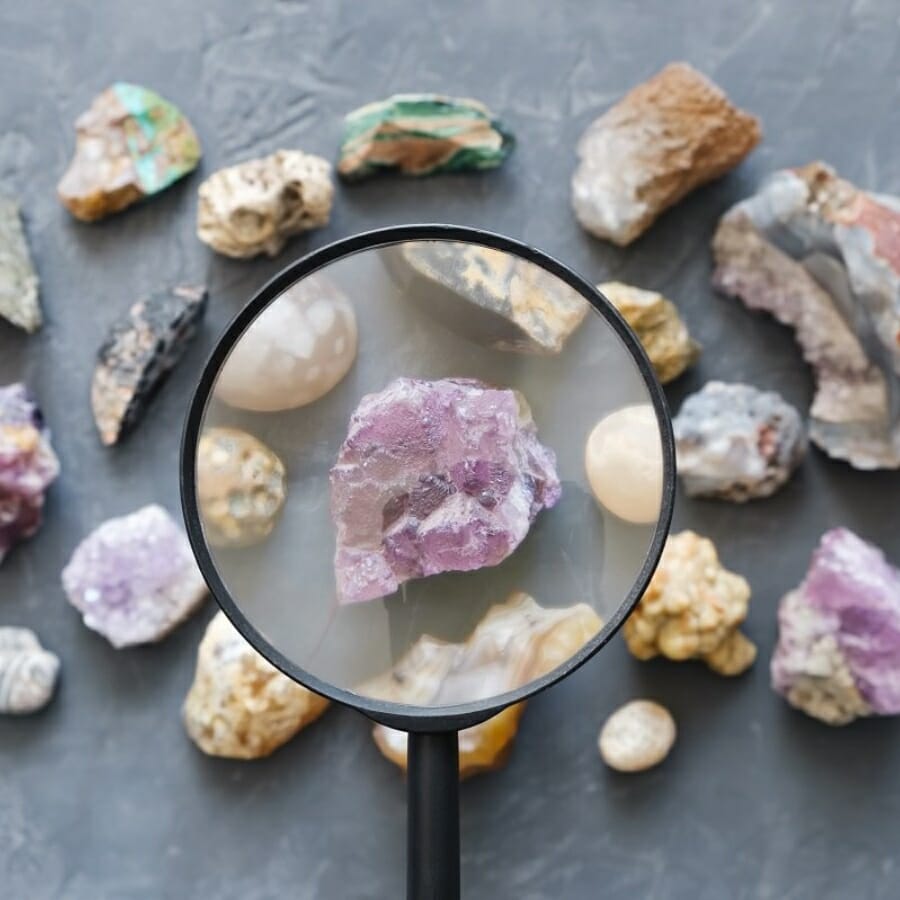
Ensure you have proper lighting to view the specimen. Natural daylight or a bright, white light source is ideal for accurate color perception. Avoid using colored light, as it can distort the specimen’s true color.
Observe the specimen’s color under the light source. Take note of the predominant color as well as any secondary colors or variations. Describe the color in terms of its hue (e.g., red, blue, green), intensity (e.g., bright, pale), and saturation (e.g., vivid, pastel).
Feel the surface of the rock or gem with your fingers. Note its texture, whether it’s smooth, rough, granular, or glassy. You can also use a hand lens or magnifying glass to examine the finer details of the texture, such as small mineral grains or crystal structures.
Look for any patterns, banding, or inclusions within the rock or gem. These can be helpful in identifying certain minerals or gemstone types.
Careful observation of color and texture, along with other physical characteristics, can provide valuable information for identifying rocks and gems. Keep in mind that some gems may have unique optical effects, such as play-of-color or iridescence, which can add to their beauty and complexity.
Conduct a hardness test
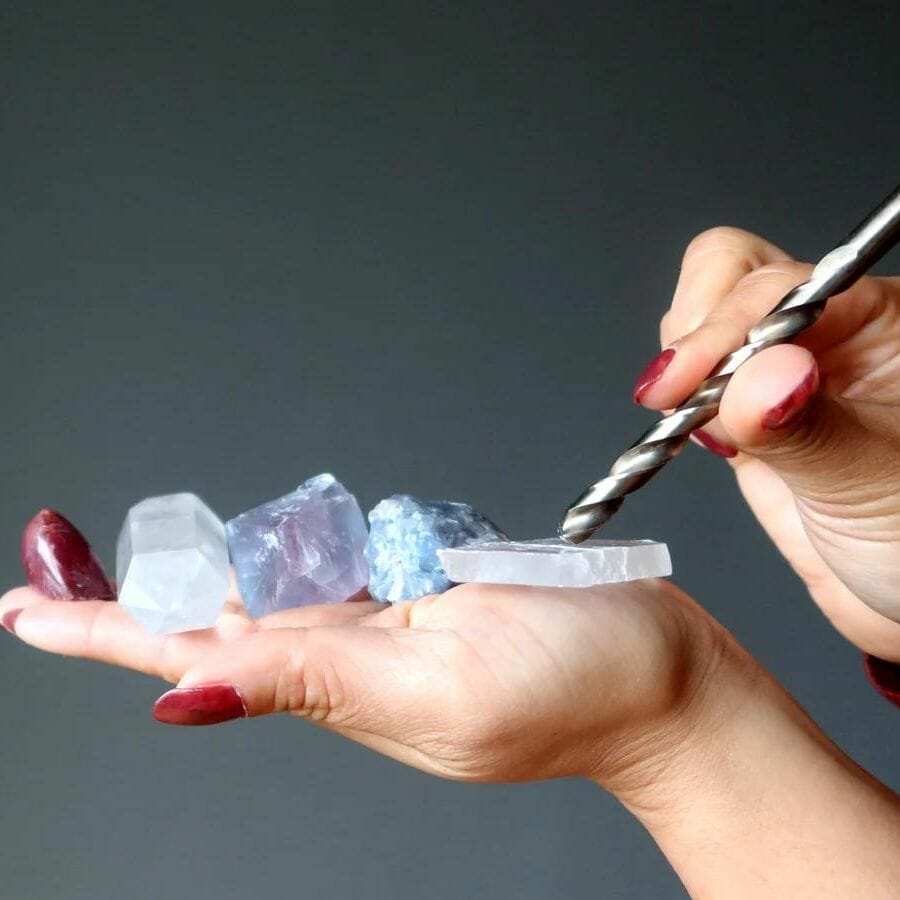
A hardness test is a simple and useful way to figure out how hard a rock, gem, or mineral is compared to other things. The test uses the Mohs scale, which ranks minerals from 1 (the softest, talc) to 10 (the hardest) (the hardest, diamond).
By comparing the hardness of the sample to the hardness of known minerals on the scale, you can narrow down the list of possible minerals and make it easier to figure out what it is.
Get a set of reference minerals whose Mohs scale hardness values are known. talc (1), gypsum (2), calcite (3), fluorite (4), apatite (5), orthoclase feldspar (6), quartz (7), topaz (8), corundum (9) and diamond (10) are all minerals that are often used as references.
Choose a part of the rock, gem, or mineral that doesn’t stand out. Hold the softest reference mineral, like talc, and try to scratch the surface of the specimen with it.
If the reference mineral can scratch the specimen, then the specimen is not as hard as the reference mineral. If you can’t see any marks or scratches, move on to the next harder reference mineral.
Test the ability of each reference mineral to scratch the specimen by repeating the process. On the Mohs scale, the mineral that leaves the most visible scratch on the specimen is the hardest reference mineral.
Keep in mind that the hardness test measures how hard a sample is compared to reference minerals. It’s not a true measurement of how hard something is. Also, don’t do the test on expensive or fragile samples that could be damaged.
Be careful when handling sharp or rough reference minerals to avoid getting hurt. If you can, ask a professional for help or find other ways to identify sensitive or valuable specimens that don’t involve damaging them.
Do a streak test
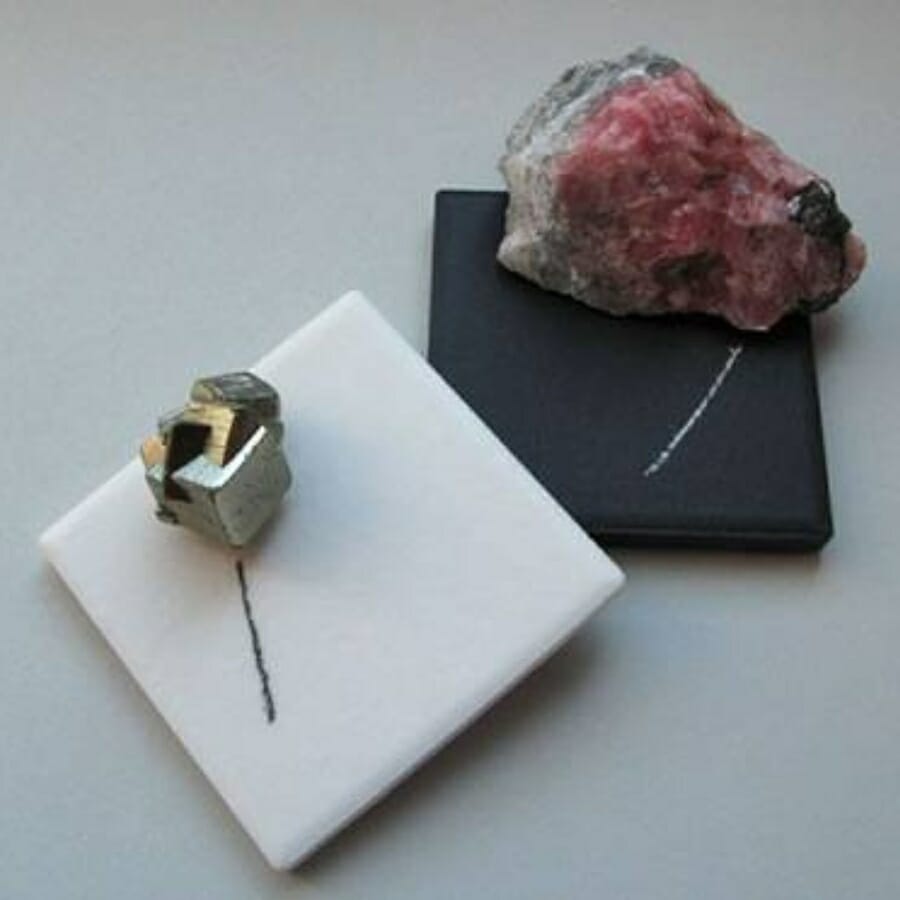
A simple and useful way to tell what minerals are is to look at the color of the powder they leave behind when scraped on a streak plate, which is an unglazed porcelain tile.
It’s especially helpful when the color of a mineral’s surface doesn’t match its true color. Minerals come in different shapes and colors, but when they are powdered, their streak color is usually the same.
Acquire an unglazed porcelain tile, often called a streak plate, which is available at most rock and mineral supply stores or online. The plate is usually white or light-colored.
Choose a flat and fresh surface of the rock, gem, or mineral you want to test. If the specimen is too hard to be scratched by the streak plate, you may need to use a hammer or other tool to break off a small fragment with a fresh surface.
Hold the streak plate at a slight angle and firmly scratch the specimen across its surface. Apply enough pressure to leave a visible mark but not too much that you risk breaking the specimen.
Examine the color of the powdered streak left on the streak plate. Note the color as accurately as possible. Some minerals may leave a streak that is different from their external color, which can aid in their identification.
Seek expert help
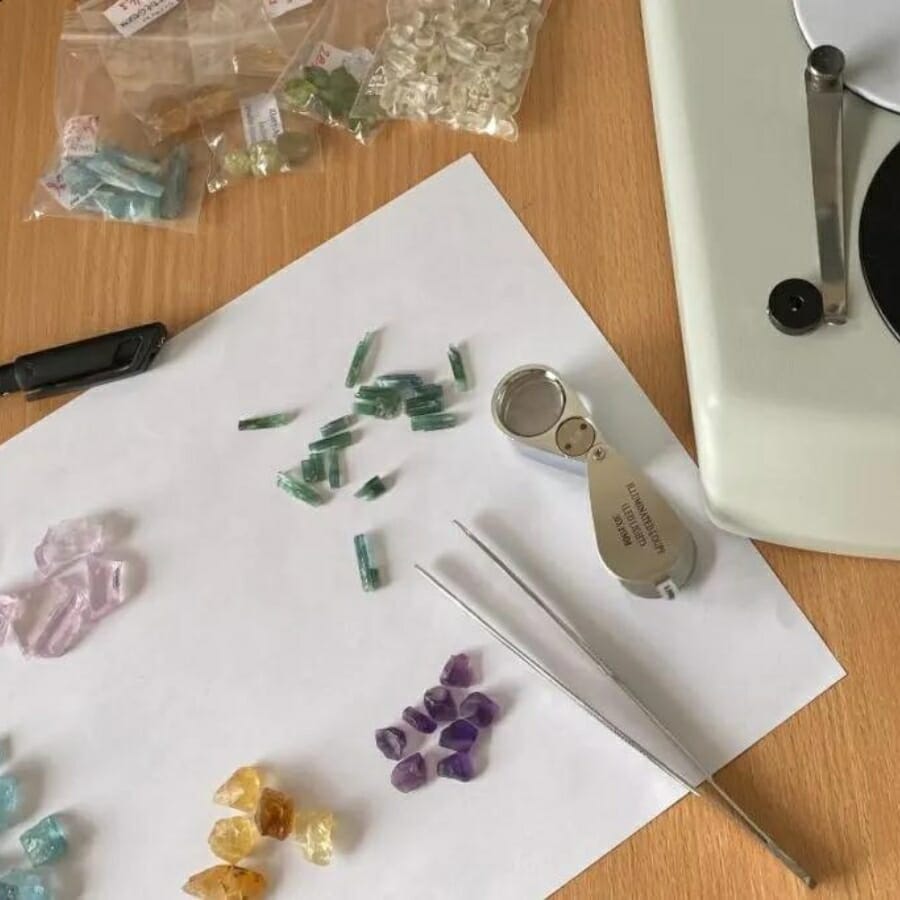
If you’re unsure about the identification, seek guidance from experienced geologists, mineralogists, or lapidary experts. Local rock clubs or gem and mineral societies can be great resources for connecting with knowledgeable individuals who can assist you in the identification process.
Contact nearby natural history museums or mineral museums. Many museums have curators or experts specializing in minerals who can help with identification or provide valuable resources.
Join online forums or social media groups dedicated to rocks, minerals, and gemstones. There, you can post pictures and descriptions of your specimen, and experienced enthusiasts may offer their input or point you to relevant resources.

